Cardiothoracic ICU Placement Reflection: Safety & Quality Standards
VerifiedAdded on 2023/06/07
|6
|1294
|320
Essay
AI Summary
This essay presents a student's reflective account of their placement experience in the Cardiothoracic ICU at Royal North Shore Hospital, focusing on medication safety and infection control, referencing the National Safety and Quality Health Service Standards. Using the 5R's of reflection (Reporting, Responding, Relating, Reasoning, and Reconstructing), the student discusses their experiences administering intravenous medications, maintaining hygiene, and adhering to infection control guidelines. The reflection highlights the importance of mindfulness, vigilance, and the five rights of medication administration in preventing errors and nosocomial infections. The student acknowledges the high-risk environment of the ICU and emphasizes the need for continuous learning, improved dosage calculation skills, and patient-centered protocols to enhance safety and cleanliness within the ICU.
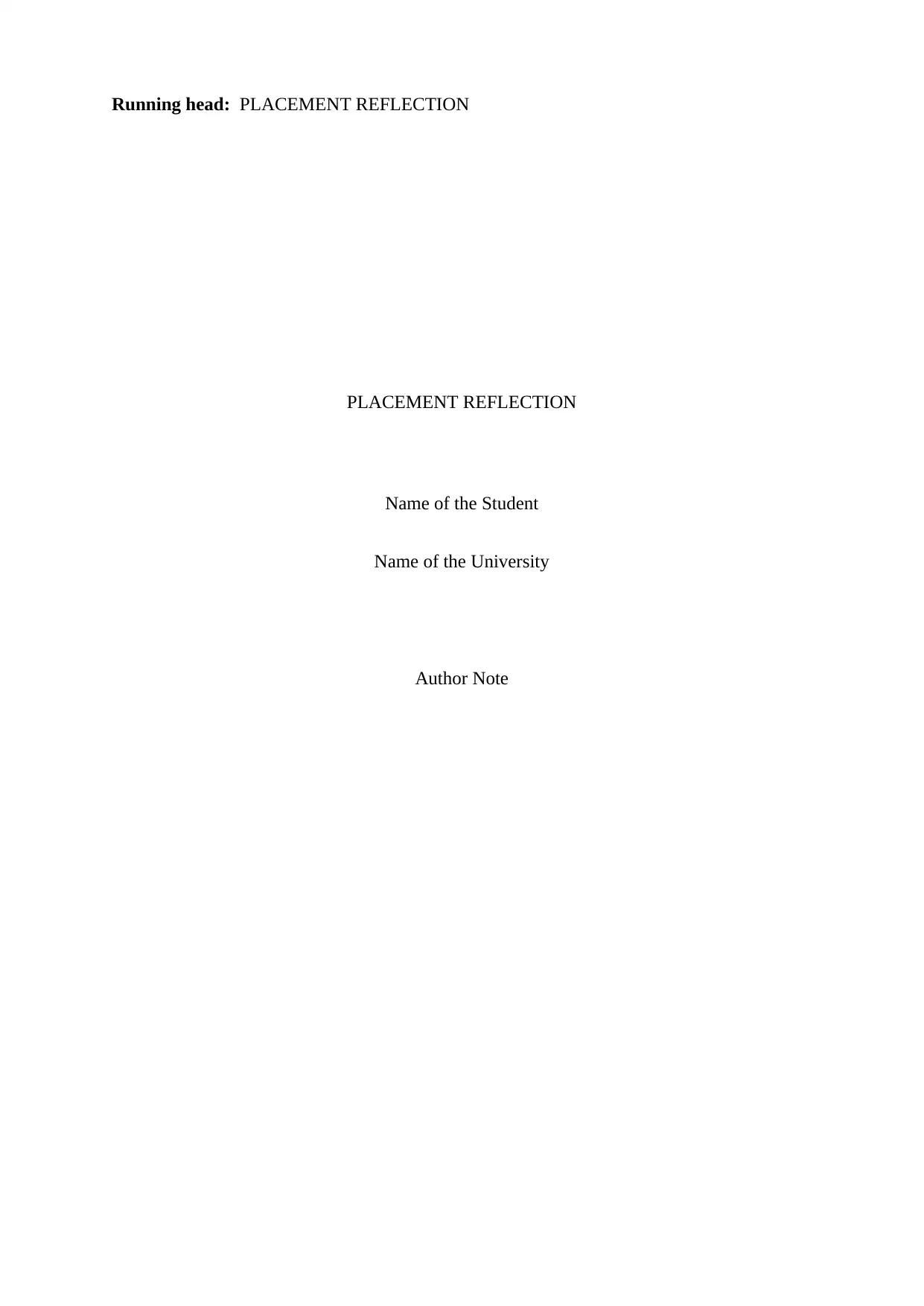
Running head: PLACEMENT REFLECTION
PLACEMENT REFLECTION
Name of the Student
Name of the University
Author Note
PLACEMENT REFLECTION
Name of the Student
Name of the University
Author Note
Paraphrase This Document
Need a fresh take? Get an instant paraphrase of this document with our AI Paraphraser
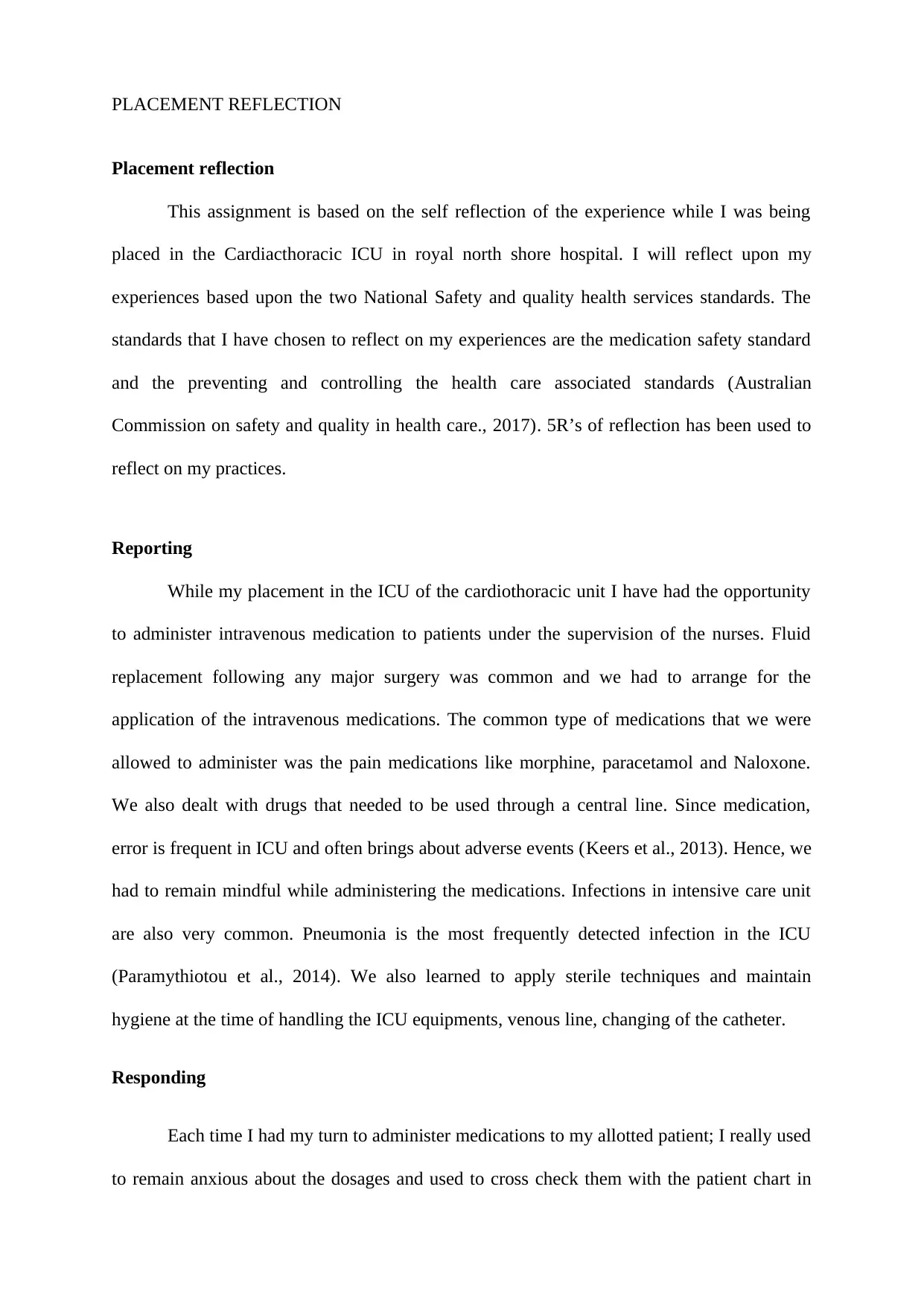
PLACEMENT REFLECTION
Placement reflection
This assignment is based on the self reflection of the experience while I was being
placed in the Cardiacthoracic ICU in royal north shore hospital. I will reflect upon my
experiences based upon the two National Safety and quality health services standards. The
standards that I have chosen to reflect on my experiences are the medication safety standard
and the preventing and controlling the health care associated standards (Australian
Commission on safety and quality in health care., 2017). 5R’s of reflection has been used to
reflect on my practices.
Reporting
While my placement in the ICU of the cardiothoracic unit I have had the opportunity
to administer intravenous medication to patients under the supervision of the nurses. Fluid
replacement following any major surgery was common and we had to arrange for the
application of the intravenous medications. The common type of medications that we were
allowed to administer was the pain medications like morphine, paracetamol and Naloxone.
We also dealt with drugs that needed to be used through a central line. Since medication,
error is frequent in ICU and often brings about adverse events (Keers et al., 2013). Hence, we
had to remain mindful while administering the medications. Infections in intensive care unit
are also very common. Pneumonia is the most frequently detected infection in the ICU
(Paramythiotou et al., 2014). We also learned to apply sterile techniques and maintain
hygiene at the time of handling the ICU equipments, venous line, changing of the catheter.
Responding
Each time I had my turn to administer medications to my allotted patient; I really used
to remain anxious about the dosages and used to cross check them with the patient chart in
Placement reflection
This assignment is based on the self reflection of the experience while I was being
placed in the Cardiacthoracic ICU in royal north shore hospital. I will reflect upon my
experiences based upon the two National Safety and quality health services standards. The
standards that I have chosen to reflect on my experiences are the medication safety standard
and the preventing and controlling the health care associated standards (Australian
Commission on safety and quality in health care., 2017). 5R’s of reflection has been used to
reflect on my practices.
Reporting
While my placement in the ICU of the cardiothoracic unit I have had the opportunity
to administer intravenous medication to patients under the supervision of the nurses. Fluid
replacement following any major surgery was common and we had to arrange for the
application of the intravenous medications. The common type of medications that we were
allowed to administer was the pain medications like morphine, paracetamol and Naloxone.
We also dealt with drugs that needed to be used through a central line. Since medication,
error is frequent in ICU and often brings about adverse events (Keers et al., 2013). Hence, we
had to remain mindful while administering the medications. Infections in intensive care unit
are also very common. Pneumonia is the most frequently detected infection in the ICU
(Paramythiotou et al., 2014). We also learned to apply sterile techniques and maintain
hygiene at the time of handling the ICU equipments, venous line, changing of the catheter.
Responding
Each time I had my turn to administer medications to my allotted patient; I really used
to remain anxious about the dosages and used to cross check them with the patient chart in
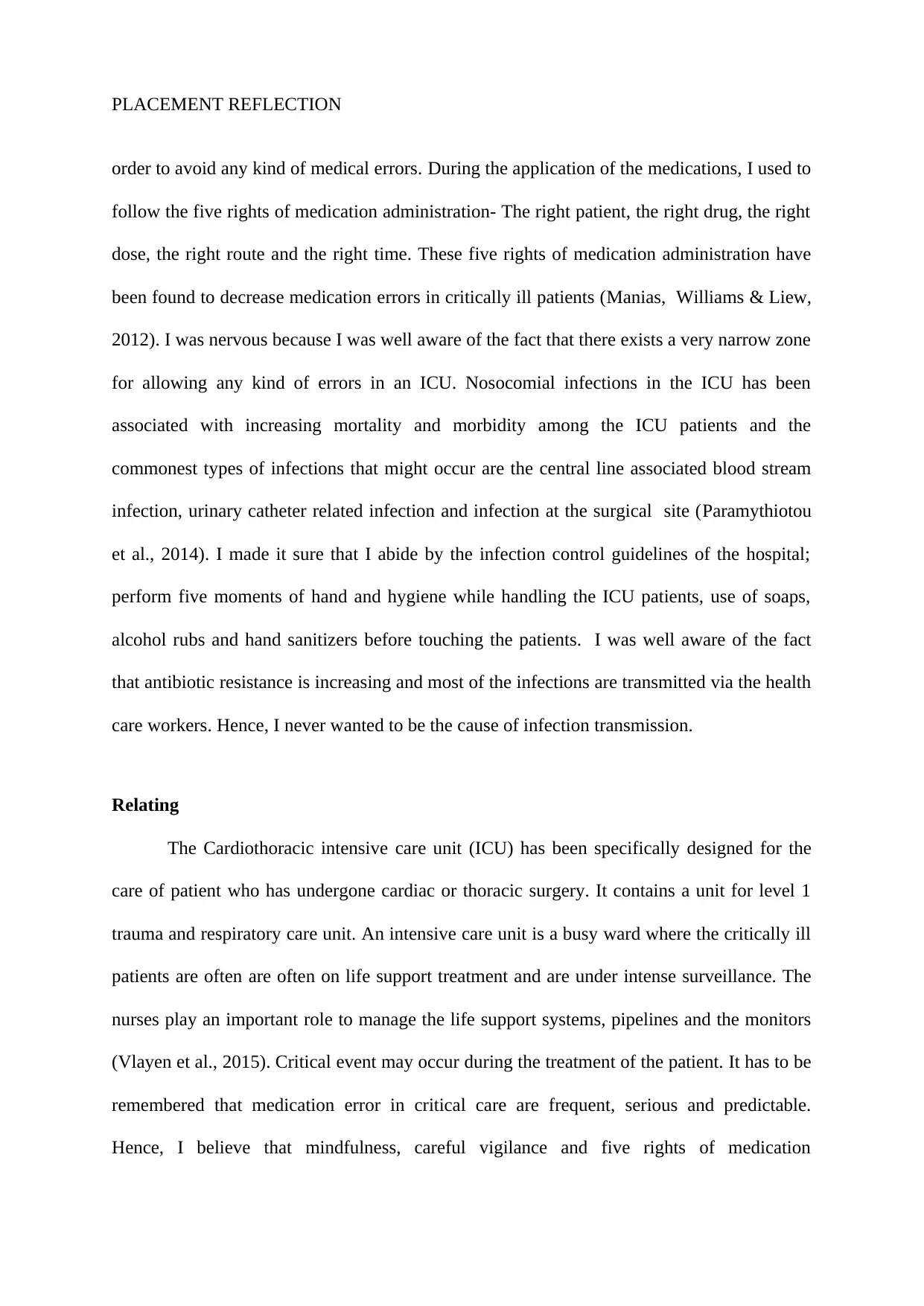
PLACEMENT REFLECTION
order to avoid any kind of medical errors. During the application of the medications, I used to
follow the five rights of medication administration- The right patient, the right drug, the right
dose, the right route and the right time. These five rights of medication administration have
been found to decrease medication errors in critically ill patients (Manias, Williams & Liew,
2012). I was nervous because I was well aware of the fact that there exists a very narrow zone
for allowing any kind of errors in an ICU. Nosocomial infections in the ICU has been
associated with increasing mortality and morbidity among the ICU patients and the
commonest types of infections that might occur are the central line associated blood stream
infection, urinary catheter related infection and infection at the surgical site (Paramythiotou
et al., 2014). I made it sure that I abide by the infection control guidelines of the hospital;
perform five moments of hand and hygiene while handling the ICU patients, use of soaps,
alcohol rubs and hand sanitizers before touching the patients. I was well aware of the fact
that antibiotic resistance is increasing and most of the infections are transmitted via the health
care workers. Hence, I never wanted to be the cause of infection transmission.
Relating
The Cardiothoracic intensive care unit (ICU) has been specifically designed for the
care of patient who has undergone cardiac or thoracic surgery. It contains a unit for level 1
trauma and respiratory care unit. An intensive care unit is a busy ward where the critically ill
patients are often are often on life support treatment and are under intense surveillance. The
nurses play an important role to manage the life support systems, pipelines and the monitors
(Vlayen et al., 2015). Critical event may occur during the treatment of the patient. It has to be
remembered that medication error in critical care are frequent, serious and predictable.
Hence, I believe that mindfulness, careful vigilance and five rights of medication
order to avoid any kind of medical errors. During the application of the medications, I used to
follow the five rights of medication administration- The right patient, the right drug, the right
dose, the right route and the right time. These five rights of medication administration have
been found to decrease medication errors in critically ill patients (Manias, Williams & Liew,
2012). I was nervous because I was well aware of the fact that there exists a very narrow zone
for allowing any kind of errors in an ICU. Nosocomial infections in the ICU has been
associated with increasing mortality and morbidity among the ICU patients and the
commonest types of infections that might occur are the central line associated blood stream
infection, urinary catheter related infection and infection at the surgical site (Paramythiotou
et al., 2014). I made it sure that I abide by the infection control guidelines of the hospital;
perform five moments of hand and hygiene while handling the ICU patients, use of soaps,
alcohol rubs and hand sanitizers before touching the patients. I was well aware of the fact
that antibiotic resistance is increasing and most of the infections are transmitted via the health
care workers. Hence, I never wanted to be the cause of infection transmission.
Relating
The Cardiothoracic intensive care unit (ICU) has been specifically designed for the
care of patient who has undergone cardiac or thoracic surgery. It contains a unit for level 1
trauma and respiratory care unit. An intensive care unit is a busy ward where the critically ill
patients are often are often on life support treatment and are under intense surveillance. The
nurses play an important role to manage the life support systems, pipelines and the monitors
(Vlayen et al., 2015). Critical event may occur during the treatment of the patient. It has to be
remembered that medication error in critical care are frequent, serious and predictable.
Hence, I believe that mindfulness, careful vigilance and five rights of medication
⊘ This is a preview!⊘
Do you want full access?
Subscribe today to unlock all pages.

Trusted by 1+ million students worldwide
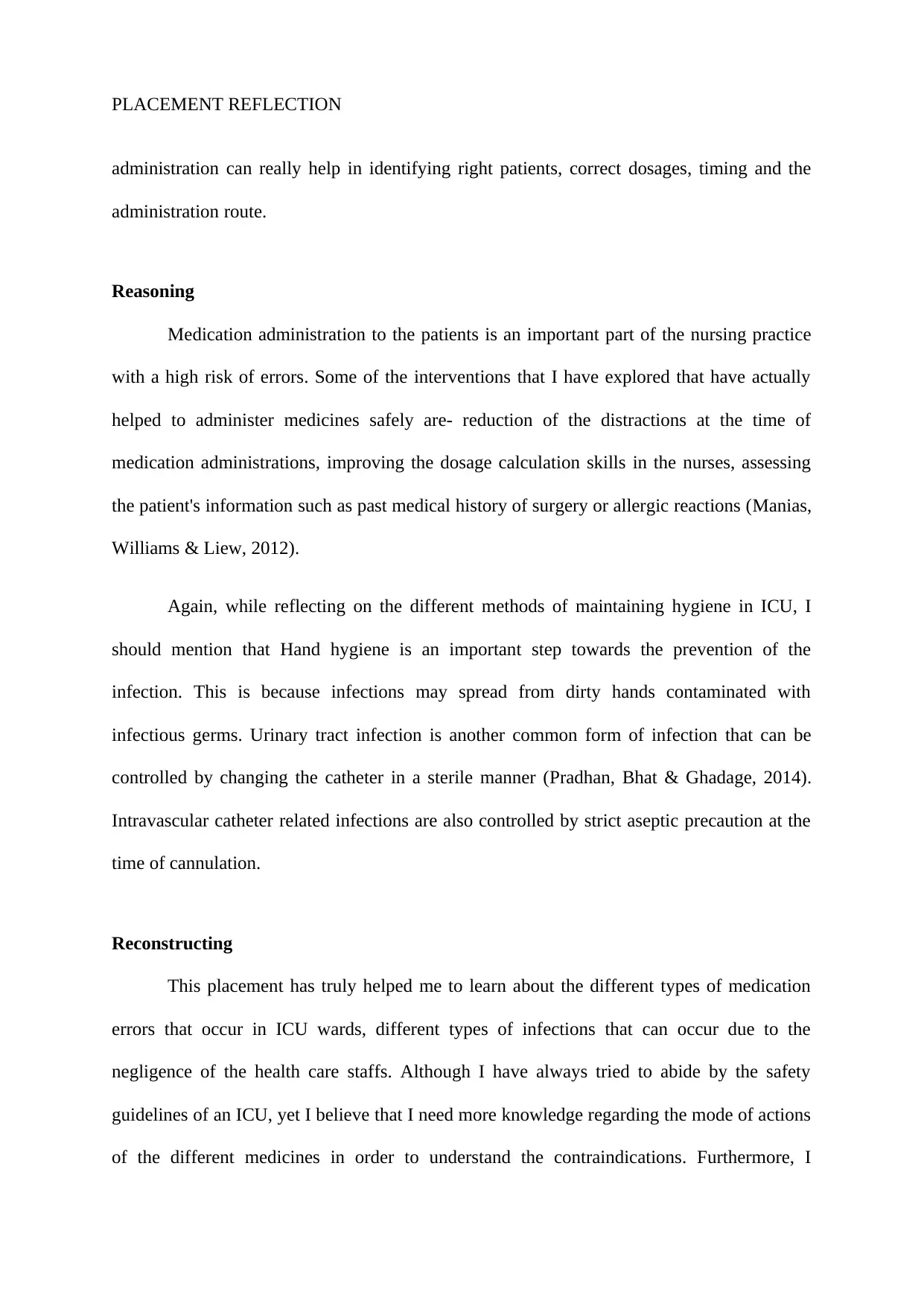
PLACEMENT REFLECTION
administration can really help in identifying right patients, correct dosages, timing and the
administration route.
Reasoning
Medication administration to the patients is an important part of the nursing practice
with a high risk of errors. Some of the interventions that I have explored that have actually
helped to administer medicines safely are- reduction of the distractions at the time of
medication administrations, improving the dosage calculation skills in the nurses, assessing
the patient's information such as past medical history of surgery or allergic reactions (Manias,
Williams & Liew, 2012).
Again, while reflecting on the different methods of maintaining hygiene in ICU, I
should mention that Hand hygiene is an important step towards the prevention of the
infection. This is because infections may spread from dirty hands contaminated with
infectious germs. Urinary tract infection is another common form of infection that can be
controlled by changing the catheter in a sterile manner (Pradhan, Bhat & Ghadage, 2014).
Intravascular catheter related infections are also controlled by strict aseptic precaution at the
time of cannulation.
Reconstructing
This placement has truly helped me to learn about the different types of medication
errors that occur in ICU wards, different types of infections that can occur due to the
negligence of the health care staffs. Although I have always tried to abide by the safety
guidelines of an ICU, yet I believe that I need more knowledge regarding the mode of actions
of the different medicines in order to understand the contraindications. Furthermore, I
administration can really help in identifying right patients, correct dosages, timing and the
administration route.
Reasoning
Medication administration to the patients is an important part of the nursing practice
with a high risk of errors. Some of the interventions that I have explored that have actually
helped to administer medicines safely are- reduction of the distractions at the time of
medication administrations, improving the dosage calculation skills in the nurses, assessing
the patient's information such as past medical history of surgery or allergic reactions (Manias,
Williams & Liew, 2012).
Again, while reflecting on the different methods of maintaining hygiene in ICU, I
should mention that Hand hygiene is an important step towards the prevention of the
infection. This is because infections may spread from dirty hands contaminated with
infectious germs. Urinary tract infection is another common form of infection that can be
controlled by changing the catheter in a sterile manner (Pradhan, Bhat & Ghadage, 2014).
Intravascular catheter related infections are also controlled by strict aseptic precaution at the
time of cannulation.
Reconstructing
This placement has truly helped me to learn about the different types of medication
errors that occur in ICU wards, different types of infections that can occur due to the
negligence of the health care staffs. Although I have always tried to abide by the safety
guidelines of an ICU, yet I believe that I need more knowledge regarding the mode of actions
of the different medicines in order to understand the contraindications. Furthermore, I
Paraphrase This Document
Need a fresh take? Get an instant paraphrase of this document with our AI Paraphraser
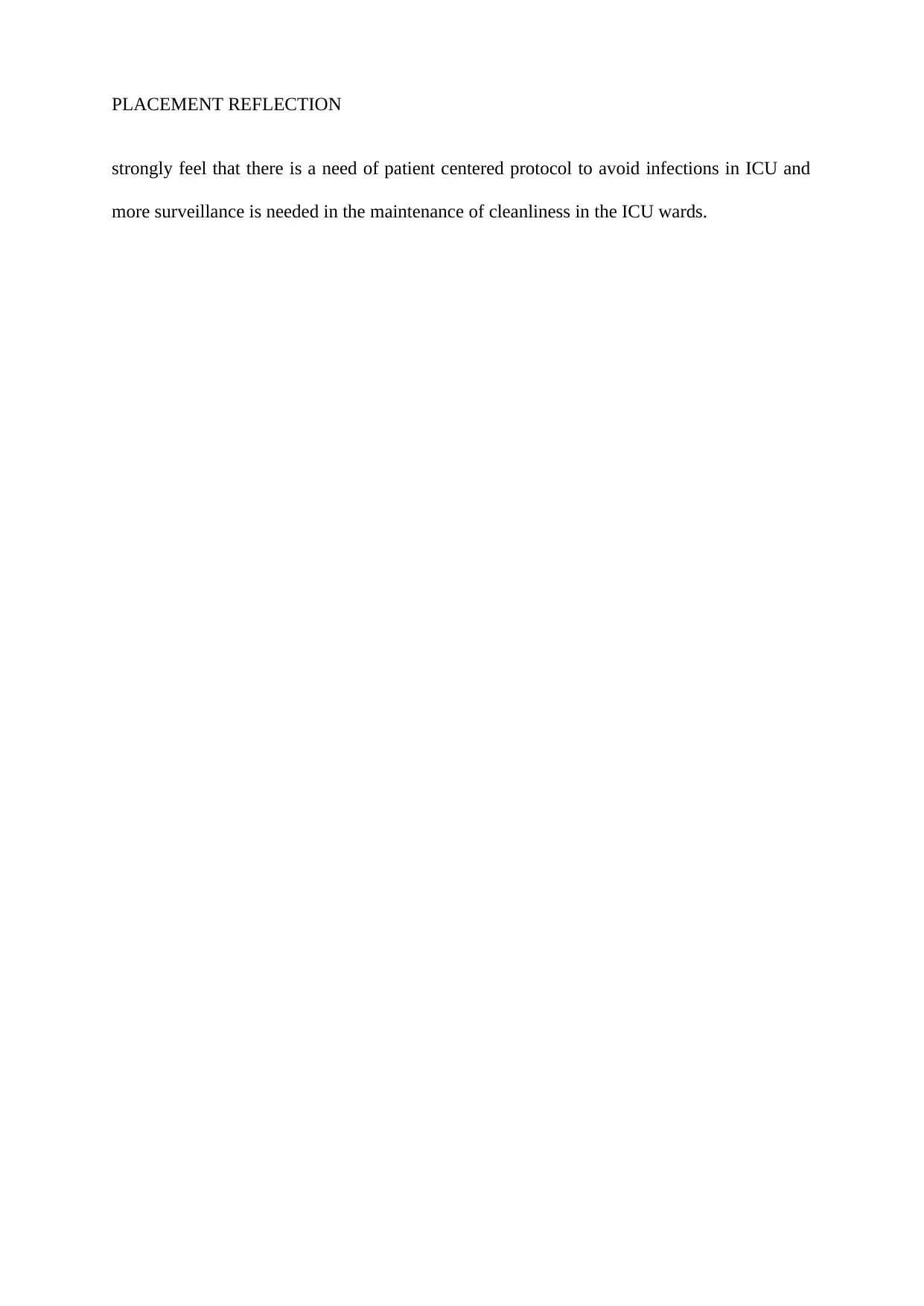
PLACEMENT REFLECTION
strongly feel that there is a need of patient centered protocol to avoid infections in ICU and
more surveillance is needed in the maintenance of cleanliness in the ICU wards.
strongly feel that there is a need of patient centered protocol to avoid infections in ICU and
more surveillance is needed in the maintenance of cleanliness in the ICU wards.
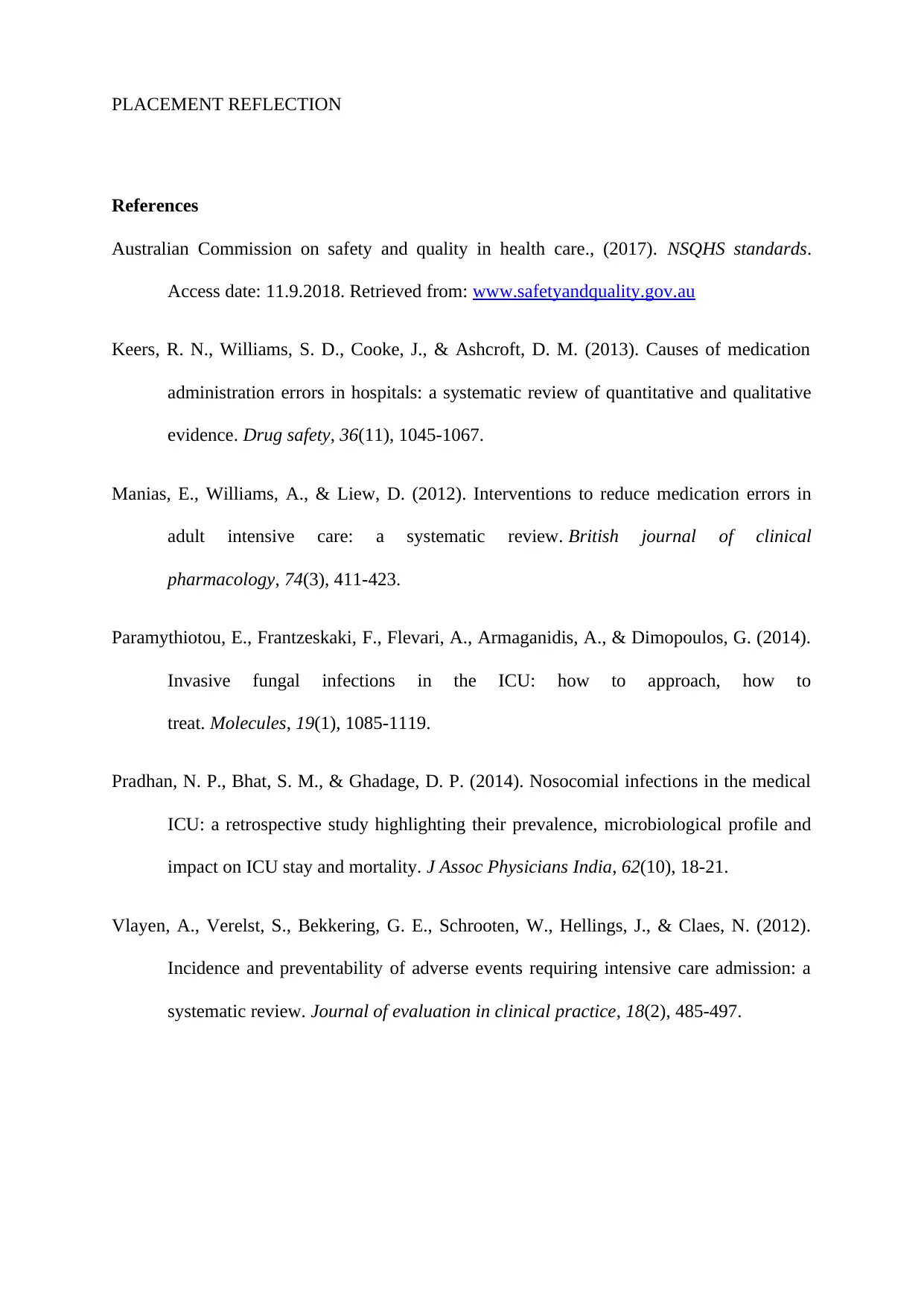
PLACEMENT REFLECTION
References
Australian Commission on safety and quality in health care., (2017). NSQHS standards.
Access date: 11.9.2018. Retrieved from: www.safetyandquality.gov.au
Keers, R. N., Williams, S. D., Cooke, J., & Ashcroft, D. M. (2013). Causes of medication
administration errors in hospitals: a systematic review of quantitative and qualitative
evidence. Drug safety, 36(11), 1045-1067.
Manias, E., Williams, A., & Liew, D. (2012). Interventions to reduce medication errors in
adult intensive care: a systematic review. British journal of clinical
pharmacology, 74(3), 411-423.
Paramythiotou, E., Frantzeskaki, F., Flevari, A., Armaganidis, A., & Dimopoulos, G. (2014).
Invasive fungal infections in the ICU: how to approach, how to
treat. Molecules, 19(1), 1085-1119.
Pradhan, N. P., Bhat, S. M., & Ghadage, D. P. (2014). Nosocomial infections in the medical
ICU: a retrospective study highlighting their prevalence, microbiological profile and
impact on ICU stay and mortality. J Assoc Physicians India, 62(10), 18-21.
Vlayen, A., Verelst, S., Bekkering, G. E., Schrooten, W., Hellings, J., & Claes, N. (2012).
Incidence and preventability of adverse events requiring intensive care admission: a
systematic review. Journal of evaluation in clinical practice, 18(2), 485-497.
References
Australian Commission on safety and quality in health care., (2017). NSQHS standards.
Access date: 11.9.2018. Retrieved from: www.safetyandquality.gov.au
Keers, R. N., Williams, S. D., Cooke, J., & Ashcroft, D. M. (2013). Causes of medication
administration errors in hospitals: a systematic review of quantitative and qualitative
evidence. Drug safety, 36(11), 1045-1067.
Manias, E., Williams, A., & Liew, D. (2012). Interventions to reduce medication errors in
adult intensive care: a systematic review. British journal of clinical
pharmacology, 74(3), 411-423.
Paramythiotou, E., Frantzeskaki, F., Flevari, A., Armaganidis, A., & Dimopoulos, G. (2014).
Invasive fungal infections in the ICU: how to approach, how to
treat. Molecules, 19(1), 1085-1119.
Pradhan, N. P., Bhat, S. M., & Ghadage, D. P. (2014). Nosocomial infections in the medical
ICU: a retrospective study highlighting their prevalence, microbiological profile and
impact on ICU stay and mortality. J Assoc Physicians India, 62(10), 18-21.
Vlayen, A., Verelst, S., Bekkering, G. E., Schrooten, W., Hellings, J., & Claes, N. (2012).
Incidence and preventability of adverse events requiring intensive care admission: a
systematic review. Journal of evaluation in clinical practice, 18(2), 485-497.
⊘ This is a preview!⊘
Do you want full access?
Subscribe today to unlock all pages.

Trusted by 1+ million students worldwide
1 out of 6
Related Documents
Your All-in-One AI-Powered Toolkit for Academic Success.
+13062052269
info@desklib.com
Available 24*7 on WhatsApp / Email
![[object Object]](/_next/static/media/star-bottom.7253800d.svg)
Unlock your academic potential
Copyright © 2020–2025 A2Z Services. All Rights Reserved. Developed and managed by ZUCOL.





